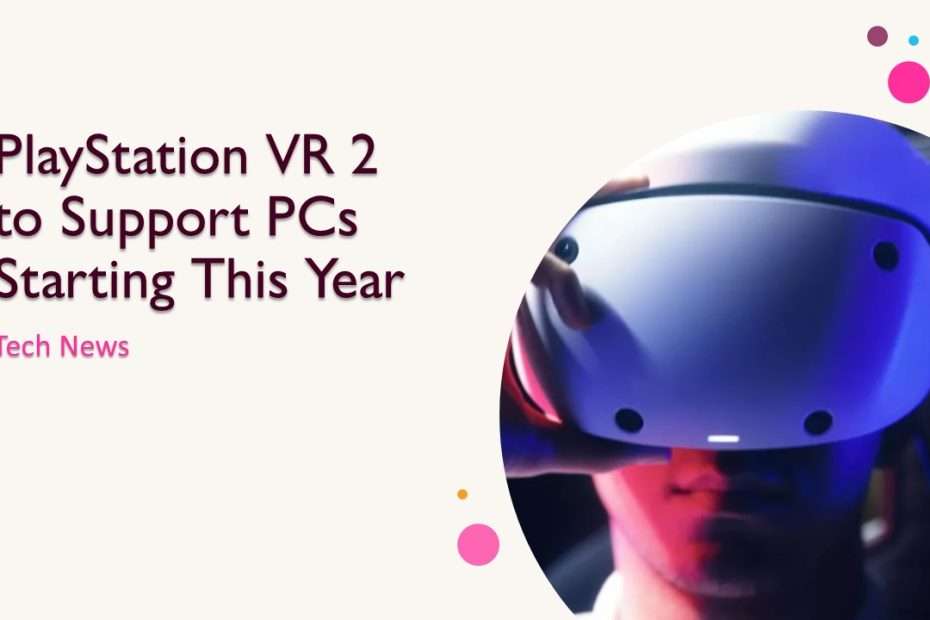Sony’s move to ensure compatibility between its PlayStation 5 headset, the PS VR2, and PCs comes at a critical time for the VR gaming industry. As worries mount about the direction of VR gaming, this decision could have a substantial impact, potentially reshaping the sector. Despite the absence of announcements regarding specific PC titles for PS VR2, its competitive pricing and advanced eye-tracking capabilities make it a compelling option for PC VR gaming enthusiasts, positioning it as a strong competitor in this expanding market.
Sony’s latest development in the VR world involves the testing of PC compatibility for its PS VR2 headset, previously only compatible with the PlayStation 5. This move signifies Sony’s commitment to expanding the accessibility of its VR technology beyond console boundaries. The company has announced plans to allow PS VR2 owners to enjoy PC games with their headset, marking a significant step towards a more versatile VR experience. This anticipated feature is set to roll out sometime this year, potentially opening up a new realm of gaming possibilities for VR enthusiasts across different platforms.
In the midst of an update on the forthcoming PS5 VR titles, Sony made a somewhat ambiguous announcement regarding the compatibility of its headset with PCs. While the details remain sparse, this revelation holds potential for significant implications. Should Sony’s PS VR2 headset indeed support platforms like SteamVR and OpenXR, it could establish itself as a strong contender in the PC headset market. This move could pave the way for a broader user base, appealing to both PlayStation and PC gamers alike, potentially solidifying Sony’s position in the VR industry across multiple platforms.
Sony’s PS VR2 received accolades upon its launch in early 2023, with reviewers commending its impressive screen resolution and affordable pricing. However, criticism arose due to Sony’s decision to confine the device solely to the PlayStation 5, limiting access to its relatively modest library of VR games. By exploring compatibility with PCs and the vast array of PC VR software available, Sony could strategically broaden the reach and appeal of the PS VR2. This move has the potential to attract a more diverse user base, tapping into the expansive PC gaming community and addressing concerns about the headset’s previous platform exclusivity.
Expanding the PS VR2’s compatibility beyond the PlayStation ecosystem could prove beneficial for Sony’s VR ambitions. Not only does it open doors to a wider selection of VR titles, but it also positions the headset as a more versatile and appealing option for consumers. By aligning with the extensive PC VR software market, Sony has the opportunity to establish the PS VR2 as a competitive player in the broader VR industry, potentially increasing its market share and solidifying its presence in the evolving landscape of virtual reality gaming.
Sony’s announcement regarding the PC compatibility of the PS VR2 has sparked speculation about the potential titles that could become accessible on the headset outside of the PlayStation ecosystem. While specific titles were not mentioned, there is excitement around the possibility of popular multiplatform games that already offer VR experiences on consoles and PCs, such as Tetris Effect and No Man’s Sky, becoming available on the PS VR2. However, the real game-changer would be if Sony were to enable PC compatibility in a manner similar to the Meta Quest 2 and 3. This would open the door to a wealth of notable games currently unavailable on the PS VR2, including highly acclaimed titles like Half-Life: Alyx, Microsoft Flight Simulator, Myst, and many others, significantly expanding the VR gaming library for PS VR2 owners.

The specifications of the PlayStation VR 2 position it competitively among current PC VR headsets. Sporting a resolution of 2,000 x 2,040 per eye, a maximum frame rate of 120Hz, OLED screens, and a 110-degree field of view, its features closely mirror those of the $500 Meta Quest 3, albeit at a slightly higher price point of $550. One standout feature of the PS VR2 is its inclusion of eye-tracking technology, a capability absent in other popular headsets like the Meta Quest 3, HTC Vive Pro 2, or Valve Index. While the Meta Quest Pro also supports eye-tracking, it comes with a significantly higher price tag, nearly double that of the PS VR2, making Sony’s offering an attractive choice for those seeking advanced features at a more accessible price.
Sony’s inclusion of eye-tracking technology in the PS VR2 has the potential to introduce foveated rendering to a wider range of PC VR users. This rendering technique focuses on displaying only the portion of the screen that the user is currently looking at in full resolution, which has the dual benefit of conserving processing power and enhancing performance. Additionally, with software designed to utilize eye-tracking, users could have the ability to interact with virtual environments and interfaces solely through eye movements. This capability has been demonstrated effectively by Apple with its $3,500 Vision Pro mixed reality headset, showcasing the potential for intuitive and efficient user input in VR experiences.
Maybe you liked other interesting articles?

